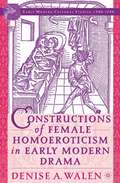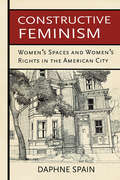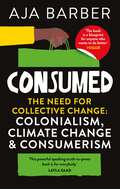- Table View
- List View
Construction Statistics Annual, 2000
by Department of the Environment, Transport and the RegionsThis is the first edition of the Construction Statistics Annual presenting a comprehensive set of statistics on the UK construction industry, current as of Summer 2000. In previous years the corresponding information was presented as the Digest of Data for the Construction Industry and as the construction part of Housing and Construction Statistics, but it replaces these and brings the material together in a single volume. This 2000 Edition of the Construction Statistics Annual gives a broad perspective of statistical trends in the construction industry in Great Britain through the last decade together with some international comparisons and features on leading initiatives which may influence the future. This new compendium provides essential, official, in-depth statistical analysis for planners, researchers, economists and construction managers.
Construction Statistics Annual, 2000
by Department of the Environment, Transport and the RegionsThis is the first edition of the Construction Statistics Annual presenting a comprehensive set of statistics on the UK construction industry, current as of Summer 2000. In previous years the corresponding information was presented as the Digest of Data for the Construction Industry and as the construction part of Housing and Construction Statistics, but it replaces these and brings the material together in a single volume. This 2000 Edition of the Construction Statistics Annual gives a broad perspective of statistical trends in the construction industry in Great Britain through the last decade together with some international comparisons and features on leading initiatives which may influence the future. This new compendium provides essential, official, in-depth statistical analysis for planners, researchers, economists and construction managers.
Construction Superintendents: Essential Skills for the Next Generation
by Len Holm John E. SchaufelbergerConstruction Superintendents: Essential Skills for the Next Generation is the first college-level textbook designed to prepare you to take on a site supervisor role on a complex jobsite. The book covers the responsibilities of superintendents in relation to the jobsite project management team, the project owners, designers, and municipal services. The book outlines the development of the superintendent and his or her role and responsibilities in twenty-first century construction projects. Using examples and case studies of cutting-edge jobsite practices from the use of computer applications to leadership and capital development, this book lays out all the functions of a modern site superintendent in an easy-to-understand format. The book includes: coverage of the full spectrum of tasks and skills required from the pre-construction phase, through start-up, operation and close-out, plus advanced topics for those serious about leading the field real-world case studies, forms, and documentation stored on a companion website chapter summaries, review questions, and exercises to aid both teaching and learning. This book fills in the long-standing need for an academic textbook designed as an applied instructional resource suitable for university and college students enrolled in construction management and construction engineering programmes.
Construction Superintendents: Essential Skills for the Next Generation
by Len Holm John E. SchaufelbergerConstruction Superintendents: Essential Skills for the Next Generation is the first college-level textbook designed to prepare you to take on a site supervisor role on a complex jobsite. The book covers the responsibilities of superintendents in relation to the jobsite project management team, the project owners, designers, and municipal services. The book outlines the development of the superintendent and his or her role and responsibilities in twenty-first century construction projects. Using examples and case studies of cutting-edge jobsite practices from the use of computer applications to leadership and capital development, this book lays out all the functions of a modern site superintendent in an easy-to-understand format. The book includes: coverage of the full spectrum of tasks and skills required from the pre-construction phase, through start-up, operation and close-out, plus advanced topics for those serious about leading the field real-world case studies, forms, and documentation stored on a companion website chapter summaries, review questions, and exercises to aid both teaching and learning. This book fills in the long-standing need for an academic textbook designed as an applied instructional resource suitable for university and college students enrolled in construction management and construction engineering programmes.
Construction Technology 1: House Construction
by Mike Riley Alison CotgraveConstruction Technology 1: House Construction offers a highly accessible introduction to the key stages of domestic house construction from planning to internal finishes. Its student-friendly layout uses detailed figures, photos and case studies from real-life building sites to aid a practical understanding of construction techniques, providing clear step-by-step guidance in learning the basic principles of low-rise residential construction. This textbook is a vital resource for students in construction, property and architecture, BSc and MSc, including any student taking courses in building surveying, quantity surveying, real estate and construction management, as well as those studying at the HNC/HND level.
Construction Technology 1: House Construction
by Mike Riley Alison CotgraveConstruction Technology 1: House Construction offers a highly accessible introduction to the key stages of domestic house construction from planning to internal finishes. Its student-friendly layout uses detailed figures, photos and case studies from real-life building sites to aid a practical understanding of construction techniques, providing clear step-by-step guidance in learning the basic principles of low-rise residential construction.This textbook is a vital resource for students in construction, property and architecture, BSc and MSc, including any student taking courses in building surveying, quantity surveying, real estate and construction management, as well as those studying at the HNC/HND level.New to this Edition:- The sections on off-site manufacture and modular approaches to construction have been significantly updated and expanded. The nature of house construction utilising panelised and volumetric approaches is explained with supporting case study examples and photographic illustrations.- The increased recognition of sustainability as a key element in modern house building is reflected in expanded consideration of the environmental implications of construction design and practice.- The characteristics of house form, construction and technology that impact upon thermal and environmental performance are included together with updated content relating to SAP calculations and target energy performance.- Advances in technology and evolving approaches to passive features of environmentally-conscious design are incorporated together with the introduction of issues around connected homes.- The material has been amended in line with current UK building regulations, environmental guidance and legislation including statutory control of the building process and health and safety.
Construction Technology 2: Industrial and Commercial Building (PDF)
by Mike Riley Alison CotgraveA new edition of this popular undergraduate textbook for the study of industrial and commercial building. This third edition is thoroughly revised including new material on sustainable construction, Building Information Modelling (BIM) and sustainable building services.
Construction the Third Way
by John BennettThis book describes current best practice in managing construction. It is based on case studies of leading practice responding to demands from customers that construction match the value and quality that international competition is forcing on their own businesses. The case studies show that major customers now partner with construction firms to find more efficient ways of working. The resulting best practice adds to these cooperative approaches a drive for efficiency and innovation based on benchmarks of world class performance that empower teams to set themselves competitive targets. So the new approach balances cooperation and competition.This is why Professor John Bennett's book is called ''Construction: The Third Way.'' The third way in modern politics balances the extremes of cooperation and competition in the interests of the whole community. At its best it encourages sustainable economic growth within a fair society. These aims are echoed in leading practice where teams able to balance cooperation and competition deliver better value for their customers and yet earn sustainably higher profits for construction.The new approach requires managers to rethink construction using ideas from fundamental science that see human organizations as self-organizing networks of relationships. This throws new light on the strengths and weaknesses of both competition and cooperation, and provides the basis for a new paradigm to guide key construction decisions. The book describes this background and provides advice about organization structures that are responsive to changing markets and technologies, and construction processes that enable the industry to earch fair profits by providing customers with the levels of value and quality they now demand.
Construction the Third Way
by John BennettThis book describes current best practice in managing construction. It is based on case studies of leading practice responding to demands from customers that construction match the value and quality that international competition is forcing on their own businesses. The case studies show that major customers now partner with construction firms to find more efficient ways of working. The resulting best practice adds to these cooperative approaches a drive for efficiency and innovation based on benchmarks of world class performance that empower teams to set themselves competitive targets. So the new approach balances cooperation and competition.This is why Professor John Bennett's book is called ''Construction: The Third Way.'' The third way in modern politics balances the extremes of cooperation and competition in the interests of the whole community. At its best it encourages sustainable economic growth within a fair society. These aims are echoed in leading practice where teams able to balance cooperation and competition deliver better value for their customers and yet earn sustainably higher profits for construction.The new approach requires managers to rethink construction using ideas from fundamental science that see human organizations as self-organizing networks of relationships. This throws new light on the strengths and weaknesses of both competition and cooperation, and provides the basis for a new paradigm to guide key construction decisions. The book describes this background and provides advice about organization structures that are responsive to changing markets and technologies, and construction processes that enable the industry to earch fair profits by providing customers with the levels of value and quality they now demand.
Constructional Engineering and Ecological Environment: Proceedings of the 4th International Symposium on Architecture Research Frontiers and Ecological Environment (ARFEE 2022), Guilin, China, 23-25 December 2022
by Chih-Huang WengConstructional Engineering and Ecological Environment contains papers presented at the 4th International Symposium on Architecture Research Frontiers and Ecological Environment (ARFEE 2022, Guilin, China, 23–25 December, 2022). With a focus on hot research topics and difficulties in construction technology and ecological environment, this book provides the latest research results on a variety of topics: building structure civil engineering seismic technology ecological environment repair The book is aimed at engineers, scholars and researchers in construction, structural engineering and environmental sciences.
Constructional Engineering and Ecological Environment: Proceedings of the 4th International Symposium on Architecture Research Frontiers and Ecological Environment (ARFEE 2022), Guilin, China, 23-25 December 2022
Constructional Engineering and Ecological Environment contains papers presented at the 4th International Symposium on Architecture Research Frontiers and Ecological Environment (ARFEE 2022, Guilin, China, 23–25 December, 2022). With a focus on hot research topics and difficulties in construction technology and ecological environment, this book provides the latest research results on a variety of topics: building structure civil engineering seismic technology ecological environment repair The book is aimed at engineers, scholars and researchers in construction, structural engineering and environmental sciences.
Constructions: An Experimental Approach to Intensely Local Architectures (Architectural Design)
by Michael Hensel Christian Hermansen CorduaThe current trend for constructing experimental structures is now an international phenomenon. It has been taken up worldwide by design professionals, researchers, educators and students alike. There exist, however, distinct and significant tendencies within this development that require further investigation. This issue of AD takes on this task by examining one of the most promising trajectories in this area, the rise of intensely local architectures. In his seminal essay of 1983, Kenneth Frampton redefined Critical Regionalism by calling for an intensely local approach to architectural design. Today, Frampton’s legacy is regaining relevance for a specific body of work in practice and education focused on the construction of experimental structures. Could this ultimately provide the seeds for a compelling and alternative approach to sustainable design? Contributors include: Barbara Ascher, Peter Buchanan, Karl Otto Ellefsen, David Jolly Monge, Lisbet Harboe, David Leatherbarrow, Areti Markopoulou, Philip Nobel, Rodrigo Rubio, Søren S Sørensen, Defne Sunguroðlu Hensel. Featured practices: Renzo Piano Building Workshop, Rintala Eggertsson, SHoP, Studio Mumbai, TYIN tegnestue.
Constructions of Female Homoeroticism in Early Modern Drama (Early Modern Cultural Studies 1500–1700)
by D. WalenThis book explores representations of love and desire between female characters in nearly seventy plays written between 1580 and 1660. The work argues that playwrights of late sixteenth- and early seventeenth-century England recognized and constructed richly diverse tropes of female homoerotic desire. Writers place female characters in erotic situations with other female characters in playful scenarios of mistaken identity, in anxious moments of amorous intrigue, in predatory situations and in enthusiastic, utopian representations of romantic love. These plays indicate an awareness of female homoeroticism in early modern England and belie statements that literary evidence of homosexuality was concerned primarily with men.
Constructive Feminism: Women's Spaces and Women's Rights in the American City
by Daphne SpainIn Constructive Feminism, Daphne Spain examines the deliberate and unintended spatial consequences of feminism’s second wave, a social movement dedicated to reconfiguring power relations between women and men. Placing the women’s movement of the 1970s in the context of other social movements that have changed the use of urban space, Spain argues that reform feminists used the legal system to end the mandatory segregation of women and men in public institutions, while radical activists created small-scale places that gave women the confidence to claim their rights to the public sphere. Women’s centers, bookstores, health clinics, and domestic violence shelters established feminist places for women’s liberation in Boston, Los Angeles, and many other cities. Unable to afford their own buildings, radicals adapted existing structures to serve as women’s centers that fostered autonomy, health clinics that promoted reproductive rights, bookstores that connected women to feminist thought, and domestic violence shelters that protected their bodily integrity. Legal equal opportunity reforms and daily practices of liberation enhanced women’s choices in education and occupations. Once the majority of wives and mothers had joined the labor force, by the mid-1980s, new buildings began to emerge that substituted for the unpaid domestic tasks once performed in the home. Fast food franchises, childcare facilities, adult day centers, and hospices were among the inadvertent spatial consequences of the second wave.
Constructivist design for 1928 Calendar Cover (large print)
by RnibThis is an image of a cover for a calendar designed by Hungarian artist Karl Dukai. There is a locator dot shown, which will be at the top left of the page when the image is the correct way up. The image shows a highly stylised industrial landscape designed with simple geometric shapes, and the year and title of the calendar. Two colours are used: black and red ochre on a pale background. In the tactile version of the design, black is shown as a thick, horizontal lined texture and red ochre as a light dotted texture. At the top centre of the page are three triangles representing smoke. They point down to three tall shapes which are the chimneys of a factory. To the right of these is the print number 1, and down the page is the number 9, the first numbers of the year 1928. To the left of the chimneys are two objects constructed from sections of circles; maybe symbolising parts of machinery. Further down the page is a thick line going diagonally up the page from left to right. This is the factory's roof. Down the page again are small rectangles in groups of two and three representing the factory's windows. On the right of the factory are the print numbers 2 with 8 down the page. Stretching across the bottom of the design is the title Népszava Naptár (People's Voice Calendar) in upper case print letters. It was published by the socialist Hungarian newspaper Népszava. The sparse geometric design of the cover is in the style of the Russian constructivists who considered art should be used for social purposes and often celebrated technology and industry.
Constructivist design for 1928 Calendar Cover (large print)
by RnibThis is an image of a cover for a calendar designed by Hungarian artist Karl Dukai. There is a locator dot shown, which will be at the top left of the page when the image is the correct way up. The image shows a highly stylised industrial landscape designed with simple geometric shapes, and the year and title of the calendar. Two colours are used: black and red ochre on a pale background. In the tactile version of the design, black is shown as a thick, horizontal lined texture and red ochre as a light dotted texture. At the top centre of the page are three triangles representing smoke. They point down to three tall shapes which are the chimneys of a factory. To the right of these is the print number 1, and down the page is the number 9, the first numbers of the year 1928. To the left of the chimneys are two objects constructed from sections of circles; maybe symbolising parts of machinery. Further down the page is a thick line going diagonally up the page from left to right. This is the factory’s roof. Down the page again are small rectangles in groups of two and three representing the factories windows. On the right of the factory are the print numbers 2 with 8 down the page. Stretching across the bottom of the design is the title ‘Nepszava Naptair’ (Peoples Voice Calendar) in upper case print letters. It was published by the socialist Hungarian newspaper Nepszava. The sparse geometric design of the cover is in the style of the Russian constructivists who considered art should be used for social purposes and often celebrated technology and industry.
Constructivist design for 1928 Calendar Cover (UEB contracted)
by RnibThis is an image of a cover for a calendar designed by Hungarian artist Karl Dukai. There is a locator dot shown, which will be at the top left of the page when the image is the correct way up. The image shows a highly stylised industrial landscape designed with simple geometric shapes, and the year and title of the calendar. Two colours are used: black and red ochre on a pale background. In the tactile version of the design, black is shown as a thick, horizontal lined texture and red ochre as a light dotted texture. At the top centre of the page are three triangles representing smoke. They point down to three tall shapes which are the chimneys of a factory. To the right of these is the print number 1, and down the page is the number 9, the first numbers of the year 1928. To the left of the chimneys are two objects constructed from sections of circles; maybe symbolising parts of machinery. Further down the page is a thick line going diagonally up the page from left to right. This is the factory's roof. Down the page again are small rectangles in groups of two and three representing the factory's windows. On the right of the factory are the print numbers 2 with 8 down the page. Stretching across the bottom of the design is the title Népszava Naptár (People's Voice Calendar) in upper case print letters. It was published by the socialist Hungarian newspaper Népszava. The sparse geometric design of the cover is in the style of the Russian constructivists who considered art should be used for social purposes and often celebrated technology and industry.
Constructivist design for 1928 Calendar Cover (UEB contracted)
by RnibThis is an image of a cover for a calendar designed by Hungarian artist Karl Dukai. There is a locator dot shown, which will be at the top left of the page when the image is the correct way up. The image shows a highly stylised industrial landscape designed with simple geometric shapes, and the year and title of the calendar. Two colours are used: black and red ochre on a pale background. In the tactile version of the design, black is shown as a thick, horizontal lined texture and red ochre as a light dotted texture. At the top centre of the page are three triangles representing smoke. They point down to three tall shapes which are the chimneys of a factory. To the right of these is the print number 1, and down the page is the number 9, the first numbers of the year 1928. To the left of the chimneys are two objects constructed from sections of circles; maybe symbolising parts of machinery. Further down the page is a thick line going diagonally up the page from left to right. This is the factory’s roof. Down the page again are small rectangles in groups of two and three representing the factories windows. On the right of the factory are the print numbers 2 with 8 down the page. Stretching across the bottom of the design is the title ‘Nepszava Naptair’ (Peoples Voice Calendar) in upper case print letters. It was published by the socialist Hungarian newspaper Nepszava. The sparse geometric design of the cover is in the style of the Russian constructivists who considered art should be used for social purposes and often celebrated technology and industry.
Constructivist design for 1928 Calendar Cover (UEB uncontracted)
by RnibThis is an image of a cover for a calendar designed by Hungarian artist Karl Dukai. There is a locator dot shown, which will be at the top left of the page when the image is the correct way up. The image shows a highly stylised industrial landscape designed with simple geometric shapes, and the year and title of the calendar. Two colours are used: black and red ochre on a pale background. In the tactile version of the design, black is shown as a thick, horizontal lined texture and red ochre as a light dotted texture. At the top centre of the page are three triangles representing smoke. They point down to three tall shapes which are the chimneys of a factory. To the right of these is the print number 1, and down the page is the number 9, the first numbers of the year 1928. To the left of the chimneys are two objects constructed from sections of circles; maybe symbolising parts of machinery. Further down the page is a thick line going diagonally up the page from left to right. This is the factory's roof. Down the page again are small rectangles in groups of two and three representing the factory's windows. On the right of the factory are the print numbers 2 with 8 down the page. Stretching across the bottom of the design is the title Népszava Naptár (People's Voice Calendar) in upper case print letters. It was published by the socialist Hungarian newspaper Népszava. The sparse geometric design of the cover is in the style of the Russian constructivists who considered art should be used for social purposes and often celebrated technology and industry.
Constructivist design for 1928 Calendar Cover (UEB uncontracted)
by RnibThis is an image of a cover for a calendar designed by Hungarian artist Karl Dukai. There is a locator dot shown, which will be at the top left of the page when the image is the correct way up. The image shows a highly stylised industrial landscape designed with simple geometric shapes, and the year and title of the calendar. Two colours are used: black and red ochre on a pale background. In the tactile version of the design, black is shown as a thick, horizontal lined texture and red ochre as a light dotted texture. At the top centre of the page are three triangles representing smoke. They point down to three tall shapes which are the chimneys of a factory. To the right of these is the print number 1, and down the page is the number 9, the first numbers of the year 1928. To the left of the chimneys are two objects constructed from sections of circles; maybe symbolising parts of machinery. Further down the page is a thick line going diagonally up the page from left to right. This is the factory’s roof. Down the page again are small rectangles in groups of two and three representing the factories windows. On the right of the factory are the print numbers 2 with 8 down the page. Stretching across the bottom of the design is the title ‘Nepszava Naptair’ (Peoples Voice Calendar) in upper case print letters. It was published by the socialist Hungarian newspaper Nepszava. The sparse geometric design of the cover is in the style of the Russian constructivists who considered art should be used for social purposes and often celebrated technology and industry.
Consumed: A Sister's Story
by Arifa Akbar'If her moving, engrossing, elegantly written memoir does not win prizes, there really is no justice in the literary world.' Lucy Atkins, Sunday TimesAll happy families are alike; each unhappy family is unhappy in its own way.When Arifa Akbar discovered that her sister had fallen seriously ill, she assumed there would be a brief spell in hospital and then she'd be home. This was not to be. It was not until the day before she died that the family discovered she was suffering from tuberculosis. Consumed is a story of sisterhood, grief, the redemptive power of art and the strange mythologies that surround tuberculosis. It takes us from Keats's deathbed and the tubercular women of opera to the resurgence of TB in modern Britain today. Arifa travels to Rome to haunt the places Keats and her sister had explored, to her grandparent's house in Pakistan, to her sister's bedside at the Royal Free Hospital in Hampstead and back to a London of the seventies when her family first arrived, poor, homeless and hungry. Consumed is an eloquent and moving excavation of a family's secrets and a sister's detective story to understand her sibling.
Consumed: The need for collective change; colonialism, climate change & consumerism
by Aja Barber'Consumed takes us through the hideously complex topic of fashion and sustainability, from its knotty colonial roots to what everyday people can do to uproot those systems, today.' - Yassmin Abdel-Magied 'SUCH integrity. Aja is no bullsh*t.' - Florence Given Aja Barber wants change. In the 'learning' first half of the book, she will expose you to the endemic injustices in our consumer industries and the uncomfortable history of the textile industry; one which brokered slavery, racism and today's wealth inequality. And how these oppressive systems have bled into the fashion industry and its lack of diversity and equality. She will also reveal how we spend our money and whose pockets it goes into and whose it doesn't (clue: the people who do the actual work) and will tell her story of how she came to learn the truth.In the second 'unlearning' half of the book, she will help you to understand the uncomfortable truth behind why you consume the way you do. She asks you to confront the sense of lack you have, the feeling that you are never quite enough and the reasons why you fill the aching void with consumption rather than compassion. And she makes you challenge this power disparity, and take back ownership of it. The less you buy into the consumer culture the more power you have.CONSUMED will teach you how to be a citizen not a consumer. 'An absolute must-read for any person who wears clothes.' - Orsola de Castro 'A hugely compelling exploration of a culture of exploitation and how, together, we can end it.' - Gina Martin 'Barber's isn't just a voice we should listen to - it is a voice we MUST listen to.' - Clementine Ford 'If you buy one book about sustainable fashion, make it this one. Consumed is an urgent call to action to demand a fashion system that is actually fair for both people and planet, not just Big Fashion billionaires. I adore Aja and I love this brilliant book.' - Venetia La Manna
Consumer Behavior in Practice: Strategic Insights for the Modern Marketer
by Eugene Y. ChanAimed at marketing students and practitioners, this book places less emphasis on theory but, instead, helps readers to understand why their customers are acting in a certain way or why their marketing activities or initiatives are not (or are) working out.The text examines the relevance of consumer behavior in such marketing topics as advertising and pricing, with topical chapters such as the sharing economy, luxury consumer behavior, and the ideological consumer. Each chapter includes boxes that highlight theory in greater depth; show how the concepts discuss “work” in actual practice; and the relevance of digital and social media marketing.This book will prove useful to those looking for a greater understanding of how consumer behavior provides greater insight about marketing activities.
Consumer Culture Reborn: The Cultural Politics of Consumption
by Martyn J. LeeFirst published in 1993. Routledge is an imprint of Taylor & Francis, an informa company.
Consumer Culture Reborn: The Cultural Politics of Consumption
by Martyn J. LeeFirst published in 1993. Routledge is an imprint of Taylor & Francis, an informa company.














